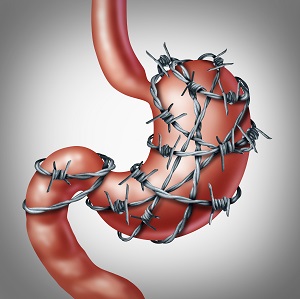
It may seem like the only things a baby can do is sleep, inhale food, make messes, and cry. Actually, babies are like icebergs: there is a lot more going on under the surface. With time and a lot of practice, you’ll learn things like: the differences between the ‘I’m hungry’ cry, the ‘I’m tired’ cry, or the ‘You’re going to have to clean up a horrible mess in a minute’ cry.
Babies often suffer from colic during their first 3 months, and they can cry for hours each day. It can get maddening. It may make you question yourself as a parent, but don’t fret; most babies have colicky moments.
What is Colic?
 Colic, or inconsolable crying, is one of those problems that can be hard to deal with. Colicky babies are oftentimes suffering from excessive gas, abdominal pain caused by spasm, or an obstruction in the intestines. You may already have tried different things to soothe your baby, without success. Most likely, the one thing that you haven’t tried, is infant massage.
Colic, or inconsolable crying, is one of those problems that can be hard to deal with. Colicky babies are oftentimes suffering from excessive gas, abdominal pain caused by spasm, or an obstruction in the intestines. You may already have tried different things to soothe your baby, without success. Most likely, the one thing that you haven’t tried, is infant massage.
The Benefits of Infant Massage
Not only does infant massage use moderate pressure to help with colic and gas, but it has also been documented that preterm babies benefited from this practice through increased weight gain, bone density, and overall behavior. It should also be noted that infant massage is a great way for a father to bond with his child.
When Should I Massage My Baby?
The good thing about infant massage is that you can start the practice as soon as the child is three days old, and you can massage your baby up to four times a day.
It is recommended that you wait at least 45 minutes after feeding your baby before performing massage on their tummies, so that the baby doesn’t spit up. It is important that you pay attention for non-verbal cues that your baby displays before, during, and after the massage. If your baby keeps turning their head away from you, or if they become stiff during the massage, it may not be the best time.
CAVEAT EMPTOR: If your child has been diagnosed with any health issues, PLEASE consult a physician before massaging your baby.
Infant Massage Techniques
 Prior to starting a massage on your baby, remove any jewelry, and make sure that your hands are warm. If possible, perform the massage in a warm, quiet place. Begin by placing your baby, laying on their back, on a blanket or towel in front of you.
Prior to starting a massage on your baby, remove any jewelry, and make sure that your hands are warm. If possible, perform the massage in a warm, quiet place. Begin by placing your baby, laying on their back, on a blanket or towel in front of you.
Before you make that initial contact, rub a little oil or cream on your hands–unscented baby oil is a popular choice. As you undress your baby, tell him or her it’s massage time.
When massaging their tummy, be sure to use firm, yet still gentle strokes. Move your hands fairly slowly, in a clockwise motion. Doing the massage strokes in a clockwise direction is important because it follows the direction of your baby’s intestines. The massaging motions can help move any gas or other intestinal blockages through, thus relieving pressure that causes upset tummies in babies.
Another important part of infant massage for relieving colic, is to perform knee to chest movements with your baby’s legs. To perform this action, simply hold your baby’s ankles, and slowly bend their legs at the knee to press their knees up to their tummy. Hold their legs in this position for a count of 6 seconds. This movement is especially effective at relieving gas in babies.
If your baby does not like doing the massage on their back, or tries to roll away, you may try an alternative method for relieving colic caused by gas. Simply lay your baby over your thigh on their tummy. This position utilizes the effects of gravity to let the pressure of your thigh press against the baby’s tummy to provide relief. Use your hand to gently rock them side to side on their tummy, using a gentle movement.
In the end, even if massage doesn’t ease your baby’s colic, it will still benefit you and your baby by helping you learn about your baby’s non-verbal cues. The important thing is to know that your baby will grow out of this stage.





